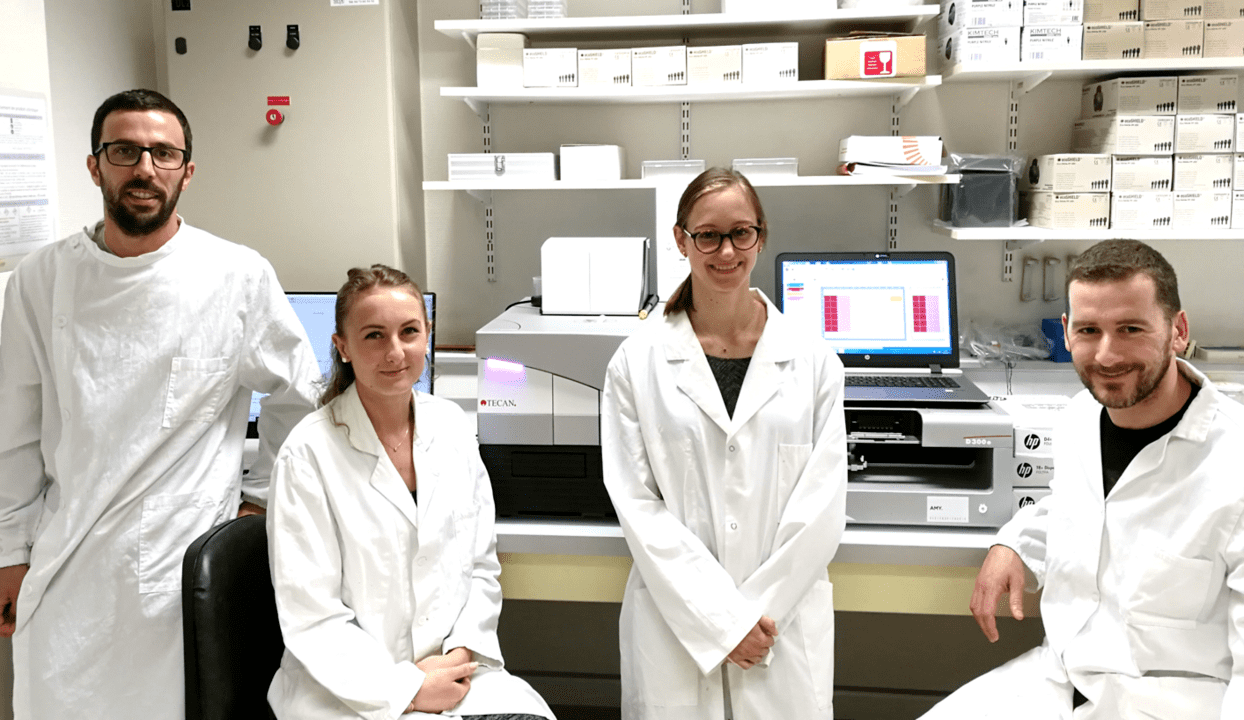The VirPath laboratory is focused on the study of influenza and other respiratory viruses to identify new antiviral molecules and develop innovative vaccines. Digital dispensing and luminescence-based assays play an important role in the evaluation of viral growth in different experimental models.
Emerging strains of influenza and other respiratory viruses pose a significant threat to global health. They have great potential to spread around the world at speed, creating a need for new and rapid response containment and control strategies. The VirPath laboratory – part of the International Center for Infectiology Research set up by the French National Institute of Health and Medical Research (Inserm), the French National Centre for Scientific Research (CNRS), the École Normale Supérieure de Lyon (ENS) and the Claude Bernard Lyon 1 University – is studying viral infections in classical cell lines and a reconstituted nasal epithelium model. The objective is to develop an understanding of the mechanisms driving virus pathogenesis and their functional interplays with the host cellular machineries. This integrated research program uses a combination of in vitro, ex vivo and animal models of infections, molecular and cellular biology and ‘omics’ approaches, and genetically engineered viruses. Olivier Terrier, a CNRS researcher in the Manuel Rosa-Calatrava team at VirPath, explained: “Our focus is mainly on respiratory viruses, such as human respiratory syncytial virus, metapneumovirus and, in particular, influenza, which are clinically prevalent and responsible for severe pathogenesis. The aim of our research is to identify new antiviral molecules and develop novel vaccines to combat these respiratory infections.”
 Members of the VirPath team with the lab’s Spark reader and D300e digital dispenser
Members of the VirPath team with the lab’s Spark reader and D300e digital dispenser
Postdoctoral researcher Andrés Pizzorno took up the story: “We have developed an innovative strategy of repositioning drugs, targeting the host cell rather than specific viral molecular determinants. The objective is to identify broad spectrum antiviral molecules that can be combined with existing molecules that target the viruses, to improve performance and reduce viral resistance. We perform transcriptome analysis of patient samples, and experiment with various in vitro and in vivo models to evaluate the effects of different treatments.” PhD student Blandine Padey added: “One of our main study models uses reconstituted human respiratory epithelium. Differentiated primary cells obtained from patient biopsies or healthy donors are cultivated at the air-liquid interface, providing an organ-level imitation of human lung epithelium that is of great biological relevance.”
The virology team takes a multidisciplinary approach to its research, and uses a Spark® multimode reader for a range of applications, including absorbance, fluorescence and luminescence measurements, nucleic acid quantification and cytotoxicity assays. Olivier explained: “The Spark was a replacement for an older, lower performance luminometer. We wanted a reader that was versatile and robust, and could be used by all members of our team. Spark met that need, offering not only the luminescence module that we required, but also options such as absorbance and fluorescence, giving us the flexibility to use other techniques as our needs change. This versatility, and the fact that we were already familiar with Tecan – we have a number of the company’s systems at the research center – was an important factor in choosing the reader, and meant that the Spark was quickly used for many more applications than luminescence. Practically all our colleagues in the laboratory use it and find it very intuitive. After a short training session, they found the Spark easy to understand and were quickly able to operate the system independently. It also helps that the system is preprogrammed for commonly used microplate formats, which we can use as a starting point for our assays.”
“We use the Spark’s luminescence module a lot, as many of our experiments depend on luciferase-expressing reporter viruses. It allows us to monitor the growth of viruses in different experimental models very precisely, and correctly evaluate the effects new molecules have on the virus reporters,” said Olivier. Andrés continued: “The reporter viruses enable simultaneous monitoring of the infection and rapid sampling, allowing us to quickly discover how the virus evolves. Comparison of the differences between treated and untreated cells then guides decision-making on new molecules.”
VirPath performs library preparation using the Universal Plus mRNA-Seq kit with NuQuant™ technology, and plans to use the Spark to certify the quality of its RNA-Seq libraries; high quality libraries are essential for the determination of high RNA-Seq signatures of different respiratory viruses or bacteria in the respiratory epithelium and at a treatment level. Blandine commented: “Performing nucleic acid quantification using the Spark and the NanoQuant Plate™ lets us collect information more quickly and easily than with other quantification techniques.”
Performing nucleic acid quantification using the Spark and the NanoQuant Plate lets us collect information more quickly and easily than with other quantification techniques.
“In addition to these applications, we perform drug combination studies. These can be quite complex and challenging to set up manually, and so we are also evaluating Tecan’s D300e Digital Dispenser. The D300e simplifies set-up of a large number of drug combinations in a microplate, which can then be read very easily and effectively in the Spark, allowing precise identification of the synergies between the different molecules. The combination of the D300e and the Spark looks promising for the future,” Andrés concluded.
To find out more about Tecan’s drug discovery solutions, visit www.tecan.com/drugdiscovery
To learn more about VirPath, go to www.virpath.com









